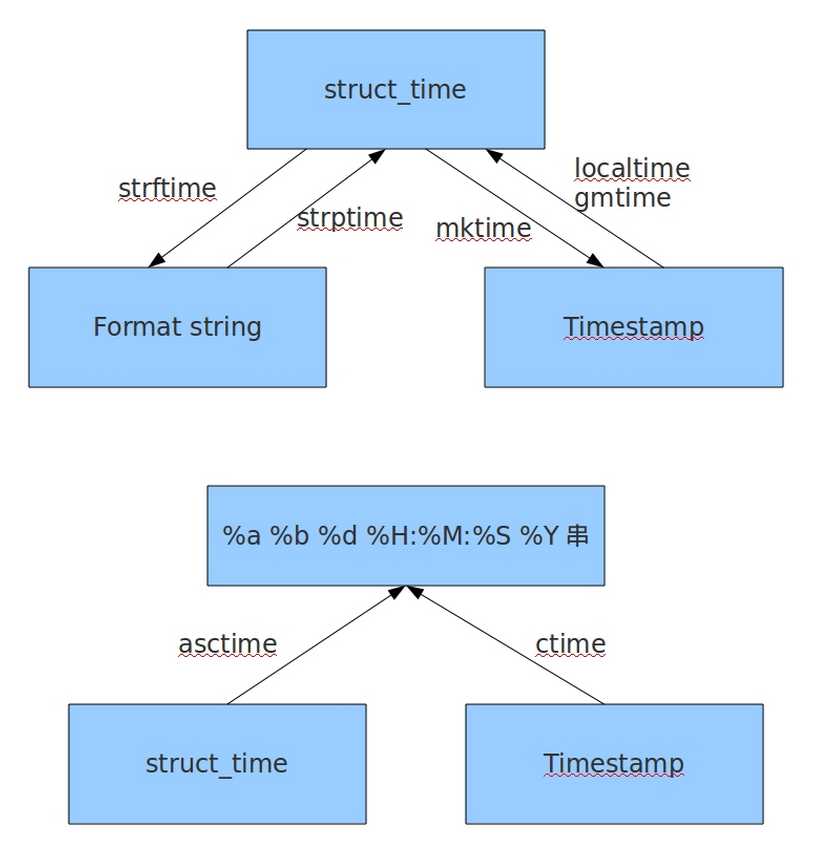【python】 time模塊和datetime模塊詳解 【轉】
阿新 • • 發佈:2018-09-05
-a cond .com ima 封裝 基本 sta times %d
一、time模塊
time模塊中時間表現的格式主要有三種:
a、timestamp時間戳,時間戳表示的是從1970年1月1日00:00:00開始按秒計算的偏移量
b、struct_time時間元組,共有九個元素組。
c、format time 格式化時間,已格式化的結構使時間更具可讀性。包括自定義格式和固定格式。
1、時間格式轉換圖:

2、主要time生成方法和time格式轉換方法實例:
1 import time 2 3 #【生成timestamp時間戳】 4 print(time.time()) 5 print(time.mktime(time.localtime())) #struct_time to timestamp 6 print(‘-‘*20) 7 8 # 【生成struct_time時間元組】 9 # timestamp to struct_time 【本地時間】 10 print(time.localtime()) 11 print(time.localtime(time.time())) 12 print(‘-‘*20) 13 # timestamp to struct_time 【格林威治時間】 14 print(time.gmtime()) 15 print(time.gmtime(time.time())) 16 print(‘-‘*20)17 #format_time(格式化時間) to struct_time(時間元組) 18 print(time.strptime(‘2014-11-11‘, ‘%Y-%m-%d‘)) 19 print(time.strptime(‘2011-05-05 16:37:06‘, ‘%Y-%m-%d %X‘)) 20 print(‘-‘*20)
struct_time元組元素結構
屬性 值 tm_year(年) 比如2011 tm_mon(月) 1 - 12 tm_mday(日)1 - 31 tm_hour(時) 0 - 23 tm_min(分) 0 - 59 tm_sec(秒) 0 - 61 tm_wday(weekday) 0 - 6(0表示周日) tm_yday(一年中的第幾天) 1 - 366 tm_isdst(是否是夏令時) 默認為-1
format time結構化表示
| 格式 | 含義 |
| %a | 本地(locale)簡化星期名稱 |
| %A | 本地完整星期名稱 |
| %b | 本地簡化月份名稱 |
| %B | 本地完整月份名稱 |
| %c | 本地相應的日期和時間表示 |
| %d | 一個月中的第幾天(01 - 31) |
| %H | 一天中的第幾個小時(24小時制,00 - 23) |
| %I | 第幾個小時(12小時制,01 - 12) |
| %j | 一年中的第幾天(001 - 366) |
| %m | 月份(01 - 12) |
| %M | 分鐘數(00 - 59) |
| %p | 本地am或者pm的相應符 |
| %S | 秒(01 - 61) |
| %U | 一年中的星期數。(00 - 53星期天是一個星期的開始。)第一個星期天之前的所有天數都放在第0周。 |
| %w | 一個星期中的第幾天(0 - 6,0是星期天) |
| %W | 和%U基本相同,不同的是%W以星期一為一個星期的開始。 |
| %x | 本地相應日期 |
| %X | 本地相應時間 |
| %y | 去掉世紀的年份(00 - 99) |
| %Y | 完整的年份 |
| %Z | 時區的名字(如果不存在為空字符) |
| %% | ‘%’字符 |
常見結構化時間組合:
print time.strftime("%Y-%m-%d %X") #2018-9-5 14:50:13
3、time加減
1 #timestamp加減單位以秒為單位 2 import time 3 t1 = time.time() 4 t2=t1+10 5 6 print time.ctime(t1)#Wed Oct 26 21:15:30 2018 7 print time.ctime(t2)
二、datetime模塊
datatime模塊重新封裝了time模塊,提供更多接口,提供的類有:date,time,datetime,timedelta,tzinfo。
1、date類
1 from datetime import * 2 import time 3 # 【靜態方法和字段】 4 print(date.max) #對象所能表示的最大、最小日期 5 print(date.min) 6 print(date.resolution)#對象表示日期的最小單位。這裏是天 7 print(date.today()) #返回一個表示當前本地日期的date對象 8 print(date.fromtimestamp(time.time())) #根據給定的時間戮,返回一個date對象; 9 10 # 【方法和屬性】 11 now = date(2018, 9, 5) 12 tomorrow = now.replace(day = 27) 13 14 print(now.replace(2012,8,8)) #生成一個新的日期對象,用參數指定的年,月,日代替原有對象中的屬性。 15 print(now,tomorrow) 16 print(‘-‘*20) 17 18 print(now.timetuple()) #返回日期對應的time.struct_time對象; 19 print(‘-‘*20) 20 21 print(now.weekday()) #返回weekday,如果是星期一,返回0;如果是星期2,返回1,以此類推; 22 print(now.isoweekday()) #返回weekday,如果是星期一,返回1;如果是星期2,返回2,以此類推; 23 print(‘-‘*20) 24 25 print(now.isocalendar()) #返回格式如(year,month,day)的元組; 26 print(now.isoformat()) #返回格式如‘YYYY-MM-DD’的字符串; 27 print(now.strftime("%Y-%m-%d"))
2、time類
1 from datetime import * 2 tm = time(23,46,10) 3 print(tm) 4 print(‘hour: %d, minute: %d, second: %d, microsecond: %d‘ % (tm.hour, tm.minute, tm.second, tm.microsecond)) 5 tm1 = tm.replace(hour=20) 6 print(‘tm1:‘, tm1) 7 print(‘isoformat:‘, tm.isoformat()) 8 print(‘strftime‘, tm.strftime("%X"))
3、datetime類
1 # 靜態方法和字段 2 from datetime import * 3 import time 4 5 print(‘datetime.max:‘, datetime.max) 6 print(‘datetime.min:‘, datetime.min) 7 print(‘datetime.resolution:‘, datetime.resolution) 8 print(‘-‘*20) 9 print(‘today():‘, datetime.today()) 10 print(‘now():‘, datetime.now()) 11 print(‘utcnow():‘, datetime.utcnow()) 12 print(‘-‘*20) 13 print(‘fromtimestamp(tmstmp):‘, datetime.fromtimestamp(time.time())) 14 print(‘utcfromtimestamp(tmstmp):‘, datetime.utcfromtimestamp(time.time())) 15 16 # 方法和屬性 17 dt=datetime.now()#datetime對象 18 print(dt.date()) 19 print(dt.time()) 20 print(dt.replace()) 21 print(‘-‘*20) 22 print(dt.timetuple()) 23 print(dt.utctimetuple()) 24 print(‘-‘*20) 25 print(dt.toordinal()) 26 print(dt.weekday()) 27 print(‘-‘*20) 28 print(dt.isocalendar()) 29 print(dt.ctime()) 30 print(dt.strftime)
4.timedelta類,時間加減
1 from datetime import * 2 3 dt = datetime.now() 4 5 dt1 = dt + timedelta(days=-1)#昨天 6 dt2 = dt - timedelta(days=1)#昨天 7 dt3 = dt + timedelta(days=1)#明天 8 delta_obj = dt3-dt1 9 10 print(type(delta_obj),delta_obj) 11 print(delta_obj.days,delta_obj.total_seconds())
5、tzinfo時區類
1 from datetime import datetime, tzinfo,timedelta 2 3 """ 4 tzinfo是關於時區信息的類 5 tzinfo是一個抽象類,所以不能直接被實例化 6 """ 7 class UTC(tzinfo): 8 def __init__(self,offset = 0): 9 self._offset = offset 10 11 def utcoffset(self, dt): 12 return timedelta(hours=self._offset) 13 14 def tzname(self, dt): 15 return "UTC +%s" % self._offset 16 17 def dst(self, dt): 18 return timedelta(hours=self._offset) 19 20 #北京時間 21 beijing = datetime(2011,11,11,0,0,0,tzinfo = UTC(8)) 22 print ("beijing time:",beijing) 23 #曼谷時間 24 bangkok = datetime(2011,11,11,0,0,0,tzinfo = UTC(7)) 25 print ("bangkok time",bangkok) 26 #北京時間轉成曼谷時間 27 print ("beijing-time to bangkok-time:",beijing.astimezone(UTC(7))) 28 29 #計算時間差時也會考慮時區的問題 30 timespan = beijing - bangkok 31 print ("時差:",timespan)
【python】 time模塊和datetime模塊詳解 【轉】
